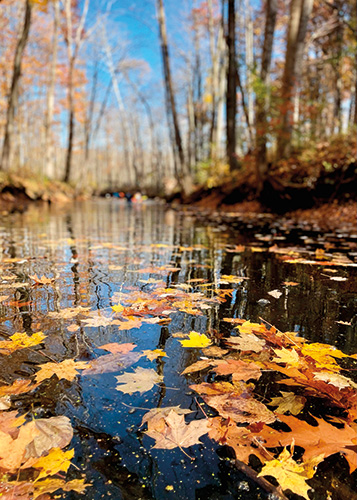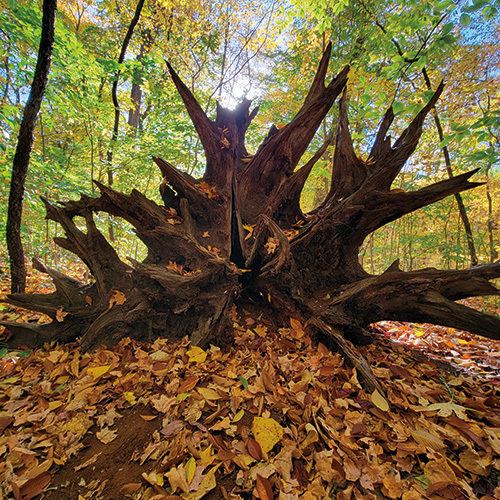About Outdoor Indiana
Outdoor Indiana, the state's premier magazine, delivers the wonders of the Hoosier outdoors to subscribers' homes and offices six times a year in 48 pages of vibrant color. For the best of state parks, lakes, wildlife, forests, trails, hunting, fishing, wildflowers and outdoorsy people, plus inside information from DNR experts, subscribe for $15 per year or $28 for two years. Follow the magazine staff on Facebook.
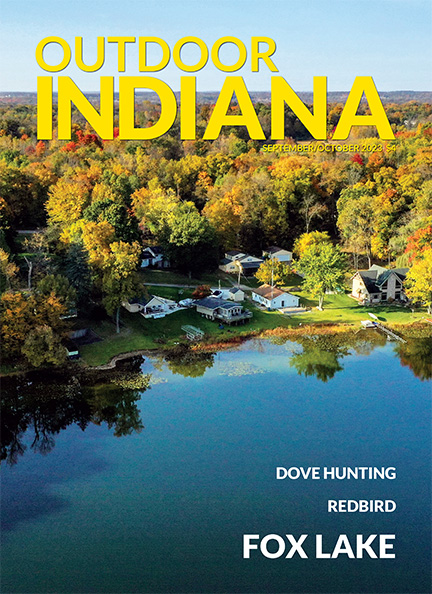
Cottages on Fox Lake, once a Green-Book destination in Steuben County and now on the National Register of Historic Places.
Photo by Brent Drinkut.
Featured Stories
- From the director
DOG DAYS OF SUMMER

DNR Director Dan Bortner
“Dogs are not our whole life, but they make our lives whole.”
Naturalist Roger A. Caras’ quote embodies life with man’s best friend. Dogs are our friends, family, and at DNR, they can also be our coworkers.
That’s true for DNR Law Enforcement, with K-9 officers working in each district. Indiana is known around the world as a leader in training K-9s for natural resources missions, with Hoosier-schooled K-9s serving as far away as the African country of Zambia. From the photo, you can see they are professionals, as well as good boys and girls.
It’s also true for our team tasked with squashing spotted lanternfly, an invasive found in two Indiana communities. Kallie Bontrager, a nursery inspector with our Division of Entomology & Plant Pathology, trained her Australian shepherds, Que and Epic, to help halt their spread. And boy do they go on the hunt, finding this pest before it hatches.
Just as with our human coworkers, the relationships we develop with our dogs are profound. Since my teenage years, Bortner basset hounds have been constant companions. Our most recent, Maizy, crossed the rainbow bridge not long ago—she was the hound of my heart and loved the outdoors!
Outdoor exploring is even more fun alongside the canine companions that “make our lives whole.” Whether a family pet like Maizy, or working K-9s, our DNR dogs love being outdoors.
Next time you visit a DNR property, check guidelines at on.IN.gov/dnrpets to see if your dog is ready to join you.
- LET’S RIDE!
Upgraded Redbird awaits off-roaders
By Scott Roberts, OI staff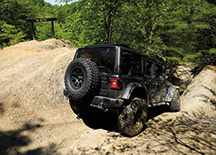
A Jeep heads down Big Bertha. Challenge areas are placed throughout Redbird; the largest lies within Trail 3’s loop. Challenge areas have few trail markings and quickly shift from being somewhat easy to extremely difficult.
Kenny Rogers of Dugger has fond memories of his father taking him to an abandoned coal mine in the early 1970s.
That may not sound like an attractive destination, but the old roads and rough terrain from years of surface and underground excavation made it an excellent spot to test off-road vehicles (ORVs), something father and son loved to witness. The area was called Redbird, the name of one of the companies that once mined there.
One of their favorite places on site was Powerline Hill, a steep slope from atop which the Antioch Power Plant once lit up the mine and the two surrounding villages, Dugger and Vicksburg. They would watch all varieties of ORVs try to reach the crest. When he got old enough, Rogers joined the party.
“I’ve had bicycles, motorcycles, four-wheelers, Jeeps, and a lot of skinned knees and palms from when I fell,” he said. “I’ve taken just about any ORV-style vehicle out there.”Rogers still loves how Redbird can differ from day to day. The trails can be calm and inviting, then rain makes them more challenging the next time he’s there.
To read the rest of this article subscribe to Outdoor Indiana or pick up a copy at one of our state park inns. To subscribe, click here or call (317) 233-3046.
- GREEN-BOOK HAVEN’S LEGACY LIVES ON
Fox Lakers relish their ‘happy place’
By Phil Boom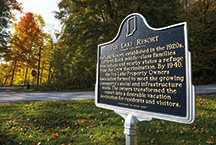
An information placard provides details of the lake’s historical significance.
The first time Kevin Colbert took his wife Debbie on a weekend trip to Fox Lake, he kept their destination a secret.
“He just said we were going away for the weekend,” she said.
He wanted to surprise her, and he did.
But Mrs. Colbert wasn’t impressed, not at first.
“It was an eye opener,” she said, describing her thoughts after they checked into their tiny room at the Mar-Fran Motel overlooking the lake’s west side.
“We had a TV that you had to turn on and off with a wire,” Debbie said. “It had a rabbit ear antenna with aluminum foil on it and a Jack and Jill restroom we shared with someone else.
“I didn’t know where we were going, so I needed to let someone know. You had to use a phone booth outside the motel, and after dark it was loaded with mosquitoes. I was taken aback.”
This trip obviously wasn’t shaping up to be the same fun-filled experience for Debbie that Kevin enjoyed over the years visiting aunts and uncles who had cottages on this lake near Angola in Steuben County.
Her outlook changed when they dined at the motel’s restaurant.
“It made you jump for joy,” she said. “I didn’t care what the room looked like; I knew I’d eat good before going home.”
Mary Frances Fleming, who managed the motel and restaurant with her husband, Harry Marcus, was widely recognized for her culinary skills.
“She could cook,” Kevin said. “That lady could cook. Of course, Fox Lakers would smell the food and try to get over there before the stuff ran out.”
Fried chicken. Peach cobbler. Green beans. Carmel cake. Homemade ice cream. And her specialty, fried corn.
Fleming cooked so many different things so well that Kevin wondered aloud, “What couldn’t she cook?”
“It was amazing,” Debbie said. “It was all right with me. It turned out to be my happy place.”
It still is, and that contentment is shared by generations of other Fox Lakers, who have built a tight-knit community that has flourished for more than 90 years and in 2001 earned recognition on the National Register of Historic Places.
Fox Lake Resort, as it was originally called, was developed specifically for Black people like the Colberts, who often faced discriminatory barriers that prevented or discouraged them from vacationing at other area resorts.
“Back in the day, Black folks were limited in where they could go and vacation,” said Detroit resident Rod Parks, whose first trip to Fox Lake was as a 10-year-old when his parents built a cottage there in 1954. “Fox Lake, a couple places in Michigan, a place in Martha’s Vineyard (in Massachusetts); that’s where people of color (like us) gathered.”
To read the rest of this article subscribe to Outdoor Indiana or pick up a copy at one of our state park inns. To subscribe, click here or call (317) 233-3046.
- HAVING A BLAST
Mourning dove hunting provides a fun challenge
By Nick Werner
Dave Bare and his son Jacob, both of Somerset, carry gear to a Mississinewa Lake mourning dove hunting field.
Dave Bare went mourning dove hunting for the first time as an adult, at the invitation of a friend.
This was about 25 years ago on a 100-degree September day at Willow Slough Fish & Wildlife Area in northwest Indiana’s Newton County. He’d spent much of his childhood hunting waterfowl along the Mississippi Flyway in Missouri, but found it did little to prepare him for the challenge.“Your first time hunting doves is an eye-opening experience,” Bare said. “Those little things are fast. I remember it taking me a couple of years before I finally shot a limit.”
Bare is one of about 9,000 active mourning dove hunters in Indiana, according to statistics from the U.S. Fish & Wildlife Service (USFWS). By comparison, about 85,000 people in Indiana hunt white-tailed deer. What the dove group lacks in numbers, though, they make up for in passion. For them, mourning dove hunting is an annual tradition, equal parts fun and frustration, and 100% fulfilling.
“It’s a blast,” Bare said. “If you get into a good field, you’re going to see hundreds, sometimes thousands of birds.”
To read the rest of this article subscribe to Outdoor Indiana or pick up a copy at one of our state park inns. To subscribe, click here or call (317) 233-3046.
Reader Photos
Each issue, Outdoor Indiana staff will select reader submitted photos to feature in the magazine. If you would like the chance to be featured, please submit your photo, along with your name and phone number to:
Please, only submit original photography that you have taken. Do not send files over 9 MB in size. JPG format is preferred.
Subscribe to Outdoor Indiana magazine
Visit the Indiana State Parks online store to subscribe. Cost is $15 for a one year subscription (6 issues) or $28 for two years (12 issues).
Donate
Printing and distribution costs for Outdoor Indiana magazine have increased. One way we’re offsetting these costs is through the Friends of Outdoor Indiana Group administered through the Indiana Natural Resources Foundation. Donations to our friends group helps keep our subscription price low and ensures we’ll be around to bring you the best of Indiana’s outdoors for years to come. Donate at the INRF website and include “Friends of Outdoor Indiana” in the “In Honor Of/In Memory Of” line.
Outdoor Indiana
402 W. Washington St., W255-B
Indianapolis, IN 46204
317-233-3046
OIorders@dnr.IN.gov

